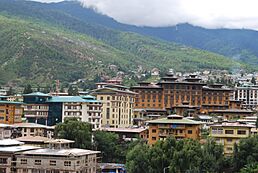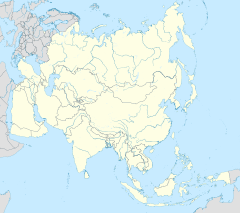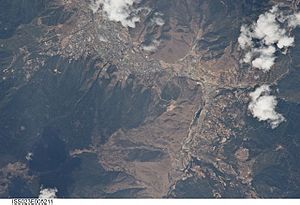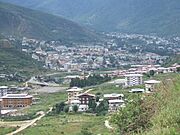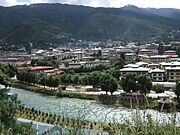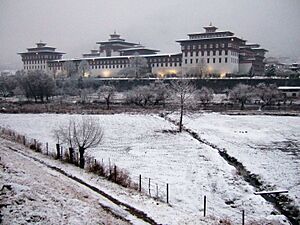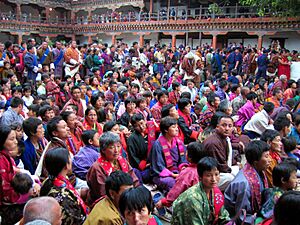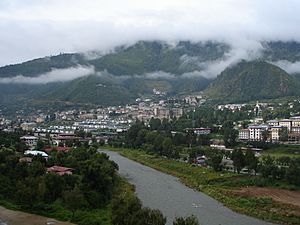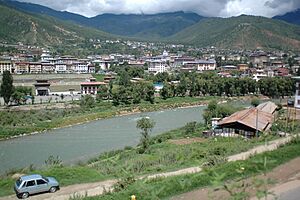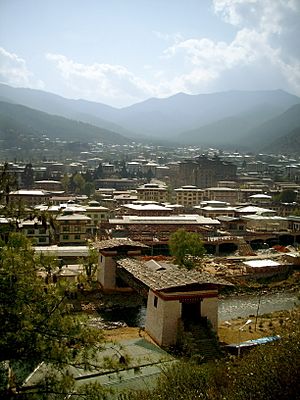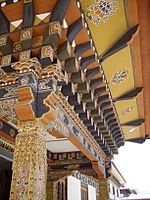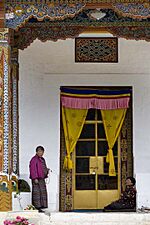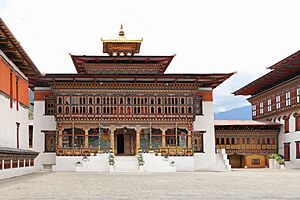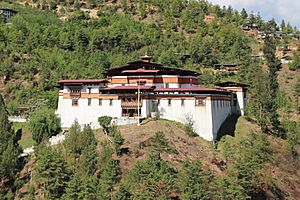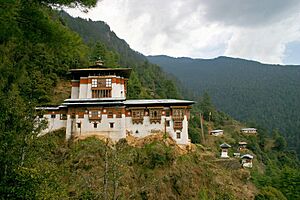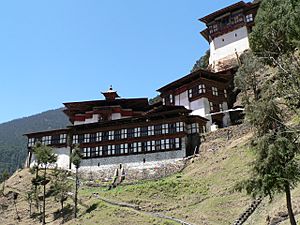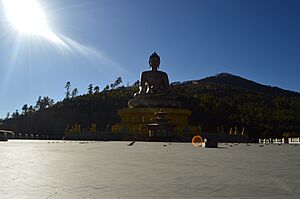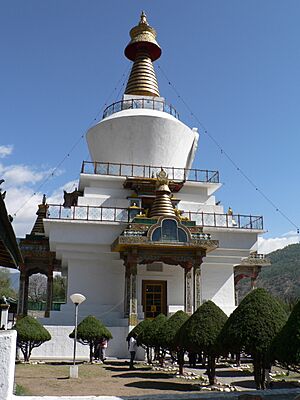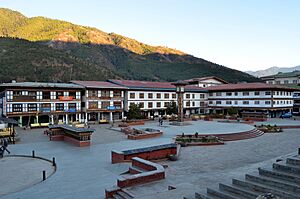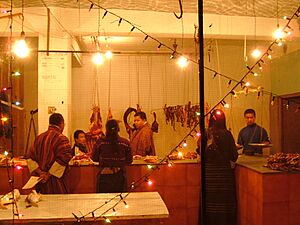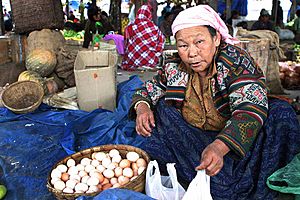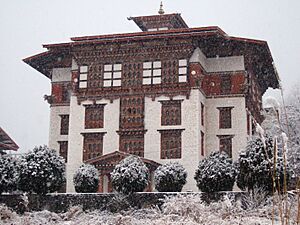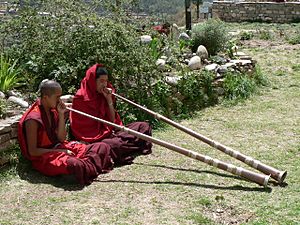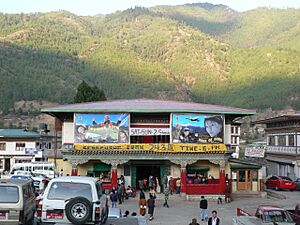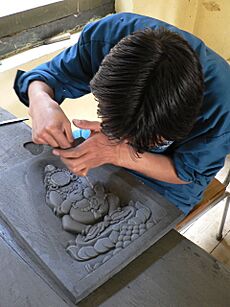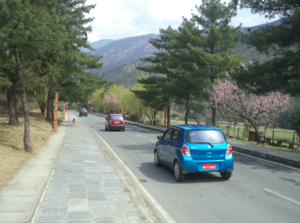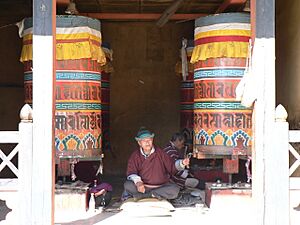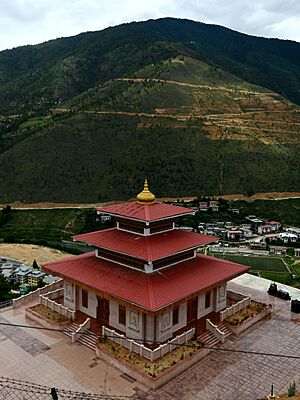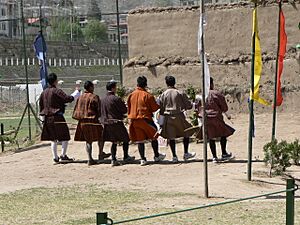Thimphu facts for kids
Quick facts for kids
Thimphu
ཐིམ་ཕུག
|
||
|---|---|---|
|
Capital city and Thromde
|
||
|
From top, left to right: Tashichho Dzong, National Library of Bhutan, an aerial view of Thimphu, Thimphu Business District
|
||
|
||
| Country | ||
| District | Thimphu | |
| Gewog | Chang | |
| Established as capital | 1955 | |
| Township | 1961 | |
| Municipality | 2009 | |
| Area | ||
| • Total | 26.1 km2 (10.1 sq mi) | |
| Elevation | 2,320 m (7,656 ft) | |
| Population
(2017)
|
||
| • Total | 114,551 | |
| • Density | 4,389/km2 (11,370/sq mi) | |
| Time zone | UTC+06:00 (BTT) | |
| Area code(s) | +975-2 | |
| Climate | Cwb | |
Thimphu (pronounced "Tim-poo") is the capital and largest city of Bhutan. It is located in the western central part of Bhutan. The valley around Thimphu is one of Bhutan's districts, called the Thimphu District. Thimphu became the capital in 1955, replacing the old capital city of Punakha. In 1961, the 3rd King of Bhutan, Jigme Dorji Wangchuck, officially declared Thimphu as the capital.
The city stretches from north to south along the west side of the valley. The Wang Chhu river flows through this valley and eventually reaches India as the Raidāk River. Thimphu is one of the highest capital cities in the world, sitting between 2,248 meters (7,375 feet) and 2,648 meters (8,688 feet) above sea level. Interestingly, Thimphu does not have its own airport. People travel to Thimphu from the Paro Airport, which is about 52 kilometers (32 miles) away by road.
Thimphu is the main center for government and business in Bhutan. Farming and raising animals are very important here, making up 45% of the country's total income. Tourism is also a part of the economy, but it is carefully managed. This helps keep a balance between old traditions, new developments, and modern ways of life. Many important government buildings are in Thimphu, including the National Assembly (where laws are made) and Dechencholing Palace, the King's official home. The city's growth is guided by a plan called the "Thimphu Structure Plan, 2002-2027." This plan aims to protect the valley's natural environment. The World Bank and Asian Development Bank have helped fund some of this development.
Bhutan's culture is very strong in Thimphu. You can see it in the literature, religion, customs, and even the national dress code. Monasteries, music, and dance are also big parts of the culture. The Tshechu is a major festival where special mask dances, called Cham dances, are performed at the Tashichho Dzong. This four-day festival happens every year in September or October, based on the Bhutanese calendar.
Contents
- Exploring Thimphu's Past
- Thimphu's Location and Weather
- Who Lives in Thimphu?
- How Thimphu is Organized
- Thimphu's Unique Buildings
- Thimphu's Economy
- Keeping Law and Order
- Thimphu's Culture and Arts
- Religion in Thimphu
- Learning in Thimphu
- Getting Around Thimphu
- Sister Cities
- Sports in Thimphu
- Media in Thimphu
- See also
Exploring Thimphu's Past
Before the 1960s, Thimphu was just a few small villages spread across the valley. These included places like Motithang, Changangkha, and Taba, which are now parts of the city. In 1885, an important battle took place at what is now the Changlimithang sports ground. The victory there helped Ugyen Wangchuck become the first King of Bhutan and control the whole country. Since then, the sports ground has been very important for the city, hosting football, cricket, and archery. The modern Changlimithang Stadium was built on this site in 1974.
Under the Wangchuck family, Bhutan experienced peace and progress. The third king, Jigme Dorji Wangchuck, made many changes. He ended serfdom (where people were like property) and reformed land ownership and taxes. He also improved the government, law-making, and justice systems. In 1952, the capital was moved from Punakha to Thimphu. In 1961, Thimphu officially became the capital of Bhutan. The fourth king, Jigme Singye Wangchuck, opened the country to development, with help from India.
Bhutan joined the Colombo Plan in 1962 and the United Nations in 1971. As more international groups and embassies came to Thimphu, the city grew very quickly.
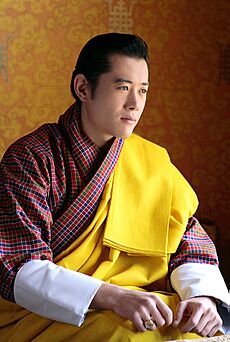
In 1998, the fourth king gave more power to a council of ministers chosen by the people. He also allowed the parliament to remove the king if needed. In 2001, work began in Thimphu to write the Constitution of Bhutan. In 2005, the fourth king announced he would pass the throne to his son, Prince Jigme Khesar Namgyal Wangchuk. The new king's coronation happened in Thimphu in 2008 at the newly renovated Changlimithang Stadium. This event also marked 100 years of the Wangchuck family's rule.
In 2008, Bhutan changed from a kingdom ruled by one person to a country with a king and a parliament (a democratic constitutional monarchy). Thimphu became the center of this new government. The country's main goal became "Gross National Happiness" (GNH), which focuses on the well-being of its people, alongside economic growth.
Thimphu's Location and Weather
Thimphu is located in a narrow valley formed by the Raidāk River, also known as the Thimphu River. The hills around the city are between 2,000 meters (6,562 feet) and 3,800 meters (12,467 feet) high. The city itself sits between 2,248 meters (7,375 feet) and 2,648 meters (8,688 feet). These differences in height and climate affect where people live and what plants grow. The valley has thin forests and spreads out to the north and west. The Lungten Zampa bridge in the south connects the two sides of the Wang Chuu river, which flows through the city.
The Raidāk River starts in snow fields high in the mountains. Many smaller rivers flow into it from the Himalayan peaks, shaping the Thimphu valley. The valley has a steep eastern ridge and a gently sloping western side. Because the hills run north-south, they are exposed to moist monsoon winds. However, Thimphu Valley is on the "leeward" side (sheltered from the wind), so it's drier and has different plants, mostly pine trees. Punakha, the old capital, is on the "windward" side (facing the wind) and has more broad-leaved trees.
Thimphu has a subtropical highland climate influenced by the southwest monsoon. The monsoon rains fall from mid-April to September. Thunderstorms often happen before the rain. Heavy, continuous rain can cause landslides and block roads. Streams and rivers swell, carrying lots of debris. In winter, it's cold at night and mild during the day, with clouds, light rain, and sometimes snow. Fog can make it hard to see, which is dangerous for driving. In spring, there are strong winds and clear, dry skies.
| Weather chart for Thimphu | |||||||||||||||||||||||||||||||||||||||||||||||
|---|---|---|---|---|---|---|---|---|---|---|---|---|---|---|---|---|---|---|---|---|---|---|---|---|---|---|---|---|---|---|---|---|---|---|---|---|---|---|---|---|---|---|---|---|---|---|---|
| J | F | M | A | M | J | J | A | S | O | N | D | ||||||||||||||||||||||||||||||||||||
|
6.3
15
-2
|
9.2
17
0
|
20
19
4
|
30
22
8
|
50
25
12
|
98
27
15
|
153
27
17
|
121
27
16
|
74
26
15
|
43
24
9
|
1.2
20
3
|
3.7
17
-1
|
||||||||||||||||||||||||||||||||||||
| temperatures in °C precipitation totals in mm |
|||||||||||||||||||||||||||||||||||||||||||||||
|
Imperial conversion
|
|||||||||||||||||||||||||||||||||||||||||||||||
| Climate data for Thimphu-Simtokha (1996-2017) | |||||||||||||
|---|---|---|---|---|---|---|---|---|---|---|---|---|---|
| Month | Jan | Feb | Mar | Apr | May | Jun | Jul | Aug | Sep | Oct | Nov | Dec | Year |
| Record high °C (°F) | 24.0 (75.2) |
25.0 (77.0) |
28.0 (82.4) |
30.0 (86.0) |
32.2 (90.0) |
32.0 (89.6) |
33.0 (91.4) |
32.5 (90.5) |
31.0 (87.8) |
31.0 (87.8) |
27.0 (80.6) |
24.0 (75.2) |
33.0 (91.4) |
| Mean daily maximum °C (°F) | 14.8 (58.6) |
16.6 (61.9) |
19.3 (66.7) |
22.4 (72.3) |
24.8 (76.6) |
26.7 (80.1) |
27.0 (80.6) |
27.3 (81.1) |
26.0 (78.8) |
23.7 (74.7) |
19.7 (67.5) |
16.6 (61.9) |
22.1 (71.7) |
| Daily mean °C (°F) | 6.3 (43.3) |
8.5 (47.3) |
11.6 (52.9) |
15.1 (59.2) |
18.2 (64.8) |
21.0 (69.8) |
21.8 (71.2) |
21.7 (71.1) |
20.3 (68.5) |
16.3 (61.3) |
11.5 (52.7) |
7.9 (46.2) |
15.0 (59.0) |
| Mean daily minimum °C (°F) | −2.2 (28.0) |
0.3 (32.5) |
3.8 (38.8) |
7.9 (46.2) |
11.6 (52.9) |
15.3 (59.5) |
16.5 (61.7) |
16.1 (61.0) |
14.6 (58.3) |
9.0 (48.2) |
3.2 (37.8) |
−0.8 (30.6) |
8.0 (46.4) |
| Record low °C (°F) | −8.5 (16.7) |
−7.0 (19.4) |
−7.0 (19.4) |
−2.0 (28.4) |
2.5 (36.5) |
8.0 (46.4) |
11.0 (51.8) |
9.0 (48.2) |
6.0 (42.8) |
−3.0 (26.6) |
−6.0 (21.2) |
−7.5 (18.5) |
−8.5 (16.7) |
| Average rainfall mm (inches) | 6.3 (0.25) |
9.2 (0.36) |
20.4 (0.80) |
29.9 (1.18) |
49.8 (1.96) |
97.7 (3.85) |
152.8 (6.02) |
120.8 (4.76) |
73.9 (2.91) |
43.1 (1.70) |
1.2 (0.05) |
3.7 (0.15) |
608.9 (23.97) |
| Average relative humidity (%) | 68.6 | 62.6 | 62.8 | 60.2 | 63.2 | 67.0 | 72.7 | 72.2 | 71.2 | 66.6 | 62.1 | 64.0 | 66.1 |
| Source: National Center for Hydrology and Meteorology | |||||||||||||
Who Lives in Thimphu?
In 2005, Thimphu city had a population of 79,185 people. By 2011, the city's population grew to about 91,000.
How Thimphu is Organized
City Districts
Changangkha
Changangkha is a district in the western central part of Thimphu. It is home to the Changangkha Lhakhang, one of the oldest temples in the Thimphu valley. This temple was started in the 13th century and has a statue of a "Thousand-armed Avalokiteśvara." It also has very large prayer wheels and huge sacred books. A famous incense factory, Nado Poedzokhang, is located above the temple.
Changzamtok
Changzamtok is a district in the southern part of the city, near the Hospital Area and the Wang Chuu river.
Chubachu
Chubachu is a central district. The Centenary Farmers Market is located here, where a weekend market is held on the west bank of the Wang Chu river. The Norzin Lam road runs through this area and has the Bhutan Textile Museum and the National Library of Bhutan.
Hospital Area
The Hospital Area is a central district in Thimphu. It is south of the Memorial Chorten and includes the main roundabout, the JDWR Hospital, and the national headquarters of the Royal Bhutan Police.
Jungshina
Jungshina is a northern district. It contains the Wangduetse Gompa.
Kawangjangsa
Kawangjangsa is a western district, north of Motithang. The Institute of Traditional Medicine, the Institute for Zorig Chusum (Arts and Crafts), the National Library, and the Folk Heritage Museum are all found here. The World Wide Fund for Nature (WWF) also has its Bhutanese office in Kawangjangsa.
Langjupakha
Langjupakha is a district in the northeast of Thimphu, on the eastern side of the Wang Chuu river. It has the Royal Banquet Hall, the SAARC building, and the National Assembly. The SAARC building was built for international conferences and now houses government ministries. The National Assembly, where Bhutan's laws are made, meets here twice a year.
Motithang
Motithang is a district in the northwest of Thimphu. It means "the meadow of pearls." This area became a residential area in the 1980s after the Motithang Hotel was built in 1974 for the coronation of King Jigme Singye Wangchuck. Today, it has many houses and gardens.
Besides the Motithang Hotel, this district has several guest houses and apartments. It also has the National Commission for Cultural Affairs, a UNICEF office, and grocery stores. Schools like Motithang Higher Secondary School are also here. A special wildlife sanctuary for the takin, Bhutan's national animal, is located in Motithang.
Sangyegang
Sangyegang is a western district. It has the Sangyegang Telecom Tower and a golf course.
Yangchenphug
Yangchenphug is an eastern district, across the Wang Chu River from the city center. It has the Lungten Zampa Middle School and Yangchenphug High School.
Zamazingka
Zamazingka is another eastern district, also across the Wang Chu River. The main road, Dechen Lam, connects it to Yangchenphug and leads to Paro.
Zilukha
Zilukha is a northern district. It contains the Drubthob Gonpa/Zilukha Nunnery, which once belonged to a famous saint. This area offers a great view of the Tashichho Dzong and has a golf course.
How Thimphu Plans Its Growth
Thimphu became the capital of Bhutan in 1952, but it was officially established in 1961. At first, it was just a small village around the Tashichhoe Dzong. The city grew slowly, then much faster after Bhutan opened up to visitors. Thimphu is now a major city with wide roads, traffic police, banks, hotels, and cultural places. This growth has also made property prices go up.
About 38.3% of the city is for homes. Other areas include government buildings (9.3%), shops (4%), health and education buildings (10.1%), and industrial areas (2%). The rest (32.5%) is open space, which the city plans to protect.
The Thimphu Structure Plan is a modern plan for the city's growth, started in 1998. Its goal is to protect the valley's delicate environment, including its rivers and forests. This plan was needed because of more cars and pressure on public services. The plan was approved in 2003 and is being carried out by the Thimphu Municipal Corporation. It is expected to cost over $1 billion, with funding from the World Bank and the Asian Development Bank.
The plan focuses on key areas like the Tashichho Dzong, the Wang Chuu river, green hills, and forests. It also includes monasteries, temples, and prayer flags. The city's southern entrance at Simtokha Dzong marks its limits.
Under a plan for 2027, much of the city center will become car-free areas with walkways, plazas, and cafes. Car traffic will be limited to the edges of the city. Parks and footpaths will be built along rivers, and no construction will be allowed near rivers or streams. City planners also said that buildings must continue to follow traditional Bhutanese architecture. Many businesses and military facilities will be moved. By 2027, the city's population is expected to reach 162,000.
City's Growth Over Time
Over the last 50 years, Thimphu has grown a lot, especially after the fourth King, Jigme Singye Wangchuck, opened Bhutan to the outside world. The city's natural areas include forests, rivers, and farmlands.
The city's growth plan for 2027 aims for modern development while keeping ancient Bhutanese culture and architecture. Buildings will still look traditional but will have modern features. The city will have all basic services like roads, water, hospitals, and schools. Important buildings include the large Tashichho Dzong, which is the center of Bhutan's government and religious life, and the Memorial Chorten, Thimphu. The King's official home, the Dechencholing Palace, is also a grand building north of the city.
The main road, Norzin Lam, has been improved and is now lined with shops, restaurants, and public buildings. In the city center, you can find apartment blocks, small family homes, and local shops. All buildings must be designed in a traditional style with Buddhist paintings. A lively weekend market near the river sells fresh food and tourist items. Most of the city's small factories are south of the main bridge. Thimphu also has many growing businesses and offices.
Thimphu's Unique Buildings
Thimphu's buildings show the special Bhutanese architecture. These include monasteries, dzongs (fortress-like structures), chortens (stupas), and royal palaces. You can also see Prayer Flags, Mani Walls, and Prayer Wheels everywhere. Some of the most famous traditional buildings are the Tashichho Dzong, Drubthob Goemba (now a nunnery), Tango Goempa, Cheri Goempa, the Memorial Chorten, Thimphu, Dechen Phodrang, and Changangkha Lhakhang. These are all old buildings with rich histories.
Since Thimphu became the capital in 1962, many new buildings have been built. These combine traditional Bhutanese designs with modern styles. Examples include the National Institute for Zorig Chusum (Arts and Crafts), the National Library, the National Assembly building, and the National Textile Museum. Even homes in Thimphu now use new building methods while keeping the traditional Bhutanese look.
- Tashichhoe Dzong
The most famous building in Thimphu is the Tashichho Dzong, which means "Fortress of the Glorious Religion." It is located on the west bank of the Wang Chuu river. This large white building has been rebuilt many times after fires and earthquakes. It serves as both a religious center for monks and an administrative center for the government. It houses the King's offices and ministries like Home Affairs and Finance. The National Assembly used to meet here but now has its own building.
- Simtokha Dzong
Simtokha Dzong, also called "Palace of the Profound Meaning of Secret Mantras," is believed to be the oldest fortress and monastery still standing in Bhutan. It was built in 1629. It's a small dzong located about 5 kilometers (3 miles) south of Thimphu. Today, it is a school for learning the Dzongkha language.
- Dechen Phodrang Monastery
Dechen Phrodrang means "Palace of Great Bliss." This Buddhist monastery is north of Thimphu. It was originally the site of Thimphu's first Tashichhoe Dzong. In 1971, it became a monastic school with 450 student monks. The monastery has important historical items, including 12th-century paintings watched over by UNESCO, and a famous statue of Shabdrung Ngawang Namgyal.
- Dechencholing Palace
Dechencholing Palace is located at the northern end of the Thimphu valley, on the east bank of the Thimphu Chuu river. It was the home of the late Royal Grandmother. King Jigme Singye Wangchuck was born here in 1955.
- Tango Monastery
The Tango Monastery is north of Thimphu, near Cheri Mountain. It was founded in the 13th century. Locals believe this place is holy because a god appeared here. In 1616, the Tibetan saint Shabdrung Ngawang Namgyal meditated in its cave. The monastery belongs to the Drukpa Kagyu School of Buddhism. "Tango" means "horse head" in Bhutanese, referring to the main god honored there.
Tango Monastery is built like a dzong, with a curved outer wall and a tall main tower. It covers caves where saints meditated. Inside, there are prayer wheels and pictures showing the leaders of the Drukpa Kagyupa lineage.
- Cheri Monastery
Cheri Monastery, also called Chagri Dorjeden Monastery, was built in 1620 by Shabdrung Ngawang Namgyal when he was only 27. He spent many years meditating here and established the first Drukpa Kagyu monastic order in Bhutan in 1623. The monastery is about 15 kilometers (9 miles) north of Thimphu. It takes about an hour to walk up the steep hill to reach it. Ancient stories say that Padmasambhava visited this place in the 8th century. Inside the monastery, there is a silver chorten that holds the ashes of Shabdrung's father.
- Buddha Dordenma Statue
The Buddha Dordenma is a huge bronze statue of a Buddha. It sits on a hill overlooking Thimphu city, about 100 meters (328 feet) above the Wang Chuu river. This spot was once the palace of an old ruler. The giant statue, which is 51.5 meters (169 feet) tall, will hold over 100,000 smaller Buddha statues inside, all made of bronze and covered in gold. When finished, it will be one of the largest Buddha statues in the world. The statue alone cost US$47 million. It was built to celebrate 100 years of the Bhutanese monarchy and fulfills old prophecies.
- Memorial Chorten
The Memorial Chorten, also known as the 'Thimphu Chorten', is a famous chorten in Thimphu. It's located in the southern-central part of the city, near the main roundabout. This landmark, with its golden spires and bells, was built in 1974 to honor the 3rd King of Bhutan, Jigme Dorji Wangchuck. It was renovated in 2008. This chorten is different because it doesn't hold the King's remains, only his photo. The King wanted it to represent the "mind of the Buddha." It's designed in a Tibetan style, with a pyramid shape topped by a moon and sun.
Other Places to See
Thimphu has other interesting places like the National Post Office, the Clock Tower Square, and the Motithang Takin Preserve.
- National Post Office and the Bhutan Postal Museum
The National Post Office is where you can buy Bhutan's famous stamps. Bhutan was the first country to create and sell unique stamps, including 3D stamps, which are popular with collectors. The Bhutan Postal Museum opened in 2015 on the ground floor of the General Post Office building.
- Clock Tower Square
The Clock Tower Square is a recently updated area with shops and restaurants. It has fountains and traditional Bhutanese prayer wheels. The luxurious Druk Hotel is nearby. Many events and activities are held here.
- Motithang Takin Preserve
The Motithang Takin Preserve is a wildlife area for the Bhutan takin, which is the National Animal of Bhutan. It used to be a small zoo. However, the King believed it was wrong for a Buddhist country to keep animals in cages, so he ordered them to be set free. But the takin stayed in the town, looking for food. So, a special preserve was created for them to live freely. The takin became Bhutan's National Animal in 2005 because of a legend about its creation by a lama in the 15th century.
Thimphu's Economy
Thimphu is the main center for government and business in Bhutan.
A morning market is held in the central square on weekends. This is when people in Thimphu can buy fresh fruits and vegetables. During the week, they rely on supermarkets. The market also sells yak butter, cheese, wooden bowls, and fabrics. You can also find souvenirs from Nepal and goods from China and Bangladesh. In 1989, covered market halls were built for the vendors.
The Loden Foundation, Bhutan's first registered charity, has been in Thimphu since 2007. It works to support education, learning, and business in Bhutan and other Himalayan areas. It also promotes Bhutanese culture and religion around the world.
Tourism in Thimphu
When Bhutan first opened for tourism in 1974, the government set up the Tourism Corporation in Thimphu. Its goal was to organize tours focusing on Buddhism, weaving, nature, and trekking. This organization became private in 1994 and was renamed Bhutan Tourism Development Corporation. It owns hotels and cars for tourists and has interpreters for different languages.
Thimphu's nightlife is growing, with more nightclubs and pool rooms for young people. The main street, Norzim Lam, has many shops, small hotels, and restaurants. The Bhutan Textile Museum, the National Library, and the sports field are also nearby. The Clock Tower, decorated with dragons, is now an open-air theater and has art and craft stores.
Keeping Law and Order
The Royal Bhutan Police (RBP) is in charge of law and order in Thimphu and all of Bhutan. It was created in Thimphu in 1965. The RBP handles traffic control, crime prevention, and keeping the peace. In 1988, a fingerprint office was set up in Thimphu. Bhutan joined Interpol in 2005, and Interpol has an office at the RBP headquarters in Thimphu.
The RBP is led by a Chief of Police, who works under the Ministry of Home and Cultural Affairs. The headquarters are in Thimphu. Police recruits are trained at centers in Zilnon, Namgyeling–Thimphu, and other places.
Thimphu's Culture and Arts
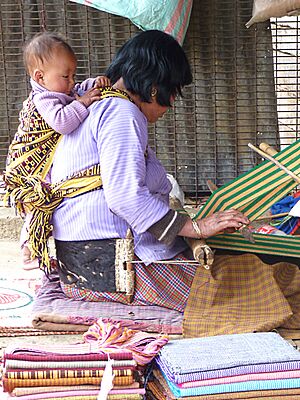
Thimphu fully reflects Bhutan's culture in its literature, religion, customs, national dress, monastic practices, music, dance, and media. Modern life has blended with traditional Buddhist values.
- Literature
Ancient Bhutanese literature is kept at the National Library. The script used is jo yig, developed in the 16th century. The library shows how these books were made by hand. Modern Bhutanese literature is still developing, with many writers now writing in English.
- Royal Academy of Performing Arts
The Royal Academy of Performing Arts (RAPA) in Thimphu was started in 1954 by the late King. Its goal is to protect and promote Bhutan's performing arts. It trains students in national dance forms like mask dances and preserves folk dances. The academy's dancers perform during the annual Thimphu Tsechu festival at the Tashichhoe Dzong.
- National Library
Established in 1967, the National Library looks like a traditional temple. It holds many old Dzongkha and Tibetan texts. It aims to save and promote Bhutan's rich literary and cultural heritage. The building is beautifully decorated and shows the best of Bhutanese architecture. On the ground floor, you can find a book said to be the heaviest in the world, weighing 59 kg (130 lb)! Traditional books made on handmade paper are also kept here. The library also has an old printing press used for books and prayer flags.
- Music
Bhutanese music has traditional styles like zhungdra and boedra. Drukpa Buddhism has greatly influenced Bhutanese culture and music. Many folk songs and chants come from Drukpa music. In the 17th century, folk music and dance became very popular. Instruments from that time include the lingm (flute), dramnyen (lute), and chiwang (fiddle). Rigsar music, a mix of traditional Bhutanese, Tibetan, and Hindi music, is now popular in Thimphu. Many Bhutanese singers produce albums in Rigsar and traditional styles.
Two music schools, Kilu Music School and Himalayan School of Music, have opened in Thimphu to promote music. Kheng Sonam Dorji, a famous musician and composer, lives in Thimphu. He plays many Bhutanese and Indian instruments and has contributed to Bhutanese pop music and film soundtracks.
- Cinema
Few films are made in Bhutan, but their quality is improving. National Film awards are given in Thimphu to encourage Bhutanese filmmaking. The only cinema hall in Thimphu, the Luger Cinema Hall, shows Bhutanese and Hindi movies, and sometimes English films.
- Thimphu Tsechu Festival
Mask dances, known as Cham dances, are performed at the Tashichhoe Dzong during the four-day Tsechu festival. This festival happens every year in Autumn (September/October) on the 10th day of the Bhutanese month. It's a religious folk dance from Drukpa Buddhism, started in 1670. Tsechus are dances performed by monks and trained dancers to honor the deeds of Padmasambahva. They are also social events where people dress in their best clothes to watch the dances and learn about Buddhism. The Thimphu Tsechu is one of the most popular, often attended by the royal family and government officials.
- Nightlife
Thimphu's nightlife is starting to grow, with more nightclubs and pool rooms opening. These places are known for their good atmosphere, entertainment, food, and music.
Arts and Crafts

Bhutan's arts and crafts are called Zorig Chosum, meaning "the thirteen arts and crafts of Bhutan." These arts show the unique spirit of the country. Arts and crafts made in Thimphu include textiles, paintings, sculptures, paper making, wood carving, sword making, and jewelry.
- National Institute of Zorig Chusum
The National Institute of Zorig Chusum is the main center for Bhutanese art education. The government set it up to preserve Bhutan's culture and traditions and to train students in all traditional art forms. Painting is a major focus, with 4–6 years of training in traditional Bhutanese art, including drawing, painting, wood carving, and embroidery.
- Handicrafts Emporiums

Near the National Institute of Zorig Chusum, there is a large government-run shop that sells beautiful handicrafts, traditional arts, and jewelry. You can find Gho and Kira, the national dress for Bhutanese men and women, here. Many other private shops in town sell thangkas (paintings), masks, brassware, and antique jewelry.
- Folk Heritage Museum
The Folk Heritage Museum in Kawajangsa, Thimphu, is built like a traditional Bhutanese farmhouse. It has furniture over 100 years old and shows a lot about rural life in Bhutan.
- Voluntary Artists Studio
The Voluntary Artists Studio encourages traditional and modern art among young people in Thimphu. The works of these young artists are also sold in the studio's 'Art Shop Gallery'.
- National Textile Museum
The National Textile Museum in Thimphu displays many beautiful and colorful Bhutanese textiles. It also shows rare kiras and ghos, which are the traditional dresses for women and men in Bhutan.
Religion in Thimphu
Vajrayana Buddhism is the official religion of Bhutan. The main group is Drukpa of Kagyu Buddhism. In southern Bhutan, Hindus of Nepali background are common. The main group of monks, with 1,160 members, is led by a Chief Abbot. He spends six months in Tashechhoe Dzong in Thimphu and six months in Punakha. A Council of Ecclesiastical Affairs in Thimphu manages the National Memorial Chorten and all Buddhist centers and schools.
Learning in Thimphu
Before the 1960s, education in Bhutan was mostly limited to monastic teachings. Only a few wealthy people went to India for Western education. Now, education has spread across the country. Dzongkha is a required language in all schools. Schools are for both boys and girls, and while education is not mandatory, it is almost free. Thimphu has many schools and colleges for different subjects. There are more private schools in Thimphu than anywhere else in Bhutan, all overseen by the Department of Education.
The Royal University of Bhutan (RUB) was founded in the city in 2003. It includes several colleges, such as the Institute for Language and Culture Studies (ILCS) at Simtokha Dzong. This institute trains students in Bhutan's national language, culture, and traditions. Graduates often become Dzongkha teachers. The Royal Institute of Health Sciences (RIHS) trains nurses and technicians, and the Royal Institute of Management (RIM) trains managers.
An IT Park is planned for Thimphu, with funding from the World Bank. This park will have a center for new businesses and a data center.
Getting Around Thimphu
Roads
Thimphu's roads are shaped by its unique landscape. Most main roads are wide and run north-south, parallel to the river. The most important road is Norzin Lam. Smaller roads wind up the hills to homes. Footpaths are also well-built. The city's entrance from the south is narrow, crossed by a wooden bridge. South of the bridge, roads lead to Paro, Punakha, and other eastern towns. A new expressway has helped development, changing land values and making travel cheaper.
The Bhutan Transport Corporation runs a regular bus service from Siliguri, India. From there, buses go to Thimphu every day. Taxis can also be hired.
One unique thing about Thimphu's roads is that it's one of only two capital cities in the world that doesn't have traffic lights. (The other is Ngerulmud, Palau). Traffic police direct cars with their dance-like movements. City bus services run all day. There are also plans to introduce tram services.
Air Travel
Thimphu is served by Bhutan's only international airport, Paro Airport, which is about 54 kilometers (34 miles) away by road. Druk Air used to have its main office in Thimphu and is one of only two airlines flying into Bhutan. It connects Bhutan to the outside world and supports tourism and trade. Tashi Air is a private airline that recently started flying in Bhutan.
Sister Cities
Sports in Thimphu
The Bhutan Olympic Committee was created in November 1983, with the King of Bhutan as its president. Its headquarters are in Thimphu. Bhutan first took part in the 1984 Summer Olympics in Los Angeles, sending archers. Since then, Bhutan has sent archers to every Summer Olympics but has never won a medal.
Archery (datse) is the national sport of Bhutan. It's played with traditional bows and arrows, as well as modern ones, at the Changlimithang Sports and Archery Stadium in Thimphu. Archery is a big part of Bhutan's culture. Women often come to watch in colorful clothes and cheer for their favorite teams. Men stand near the target and tease players who miss. The targets are 140 meters (459 feet) apart. Winning teams celebrate by singing and dancing.
Monks are not allowed to do archery, so they play daygo, a stone-throwing sport similar to discus. Another game, pungdo, is like shot put, played with heavy stones. Khuru, a dart game, is also popular.
Many modern sports are also played at the national stadium in Thimphu, including football, basketball, golf, and cricket. Thimphu has 12 cricket teams and two small golf courses. The Royal Thimphu Golf Course, a nine-hole course, was started by King Jigme Dorji Wangchuk in 1971.
- Changlimithang Stadium
Changlimithang Stadium is a multi-purpose stadium in Thimphu and is the National Stadium. It was built in 1974 for the coronation of the fourth King, Jigme Singye Wangchuck, and could hold 10,000 people. It was completely updated in 2007 to hold 25,000 spectators for the 100th anniversary of the Wangchuck dynasty and the coronation of the fifth King, Jigme Khesar Namgyal Wangchuck, in 2008. The stadium covers about 11 hectares (27 acres). This is where national celebrations have been held since the time of the third King. The Changlimithang ground is also famous for a battle in 1885 that helped establish Bhutan's first king. Next to the main stadium are a football field, a cricket field, and an archery range. The main stadium is used for many sports and events. A documentary film called "The Other Final" was made about a special football match played here between Bhutan and Montserrat.
Media in Thimphu
The Bhutan Broadcasting Service (BBS) started as a radio service in 1973, broadcasting nationally and in Thimphu. It is run by the government. In 1999, during the coronation of the fourth king, BBS began television broadcasts and satellite channels. Bhutan was the last country in the world to get television. Cable television was introduced shortly after.
Kuensel began in Thimphu as a government newsletter in 1965. It became a national weekly newspaper in 1986 and was the only newspaper in Bhutan until 2006. Kuensel, which was once government-owned, became an independent company in 1992. It publishes the newspaper in English, Nepali, and Dzongkha (Bhutanese) languages.
Radio Valley FM. 99.9, a new private radio station, has started broadcasting in Thimphu. This is in addition to older stations like BBS and Kuzoo FM.
See also
 In Spanish: Timbu para niños
In Spanish: Timbu para niños





